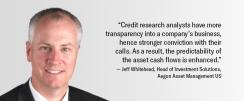Cash-flow driven investing (CDI) strategies can provide potentially strong performance and, in the best-case scenario, be tailored to the specific needs of a variety of institutions. Defined benefit (DB) pensions and Taft-Hartley plans that are underfunded and looking for an upgrade to their current fixed income strategies? Check. Endowments and foundations where “pay as you go” fundraising can leave some fulfillment challenges? CDI is designed to plug those gaps too. Nuclear decommissioning trusts as they enter the decommissioning stage? Yes – CDI sets the stage for efficiently meeting their variable cash flow needs.
Why CDI?
At its roots, a CDI strategy can provide the diversification all liability-conscious institutions seek, with return potential similar to or better than their current fixed income allocations – and then there is the additional upside that the yield or expected return can be dialed up if desired, and upcoming cash flows can be met without any forced selling when markets are volatile.
“The magnitude and timing of an institution’s liabilities are not certain, but they are often predictable,” says Jeff Whitehead, Head of Investment Solutions, Aegon Asset Management US. “A CDI portfolio can be tailored to an entity’s specific circumstances. CDI is highly customizable from a duration and credit perspective. One of the more common ways to add credit risk is to focus that additional risk on the front end of the yield curve. Credit research analysts have more transparency into a company’s business, hence stronger conviction with their calls. As a result, the predictability of the asset cash flows is enhanced.”
In the current flat/inverted yield curve environment, yields on the front end are comparable to those on the intermediate part of the curve. Many plans use the Bloomberg Barclay’s Aggregate Index as a proxy for their fixed income allocation, and as a result of the large allocations to Treasuries and mortgage-backed securities, yields aren’t especially interesting. A customized CDI portfolio can offer opportunities for potentially higher yields.
For a pension plan’s investment committee, for example, “CDI means they don’t need to constantly be in cash-raising mode and determining which funds they should be selling,” says Whitehead. “And there is less forced selling when markets are volatile. For endowments and foundations that are always gifting some portion of their overall investment portfolio, the rolling of money in and out of the system is a terrific setup for the use of a CDI portfolio.”

Customization as a core competency
Every fund—a DB plan, endowment, or nuclear decommissioning trust—has unique cash flow needs that often go beyond what can be provided by typical, off-the-shelf investments products. Customization is crucial to CDI.
To illustrate, consider the typical nuclear decommissioning trust. Since nuclear plants cannot just hang a “Gone Fission” sign on the door when they close up shop, they accumulate assets in a trust throughout the active lifetime of the plant. When active decommissioning of a reactor commences – and as you read this, it has done so at 19 nuclear reactor sites (21 reactor units total) in the U.S. – the costly process lasts many years, creating a need for sophisticated and customized cash-flow strategies.
During a decommissioning trust’s asset accumulation phase its investment strategies are typically similar to the basic 70% equities/30% fixed income allocations of DB plans. As decommissioning draws closer, the trust likely starts hedging to reduce downside risk and protect what it has earned over the years. When decommissioning itself gets under way, a CDI portfolio sharply focused on the front end of the fixed income yield curve can become the centerpiece of a trust’s investment strategy, “and be customized to match the expected cost pattern,” says Whitehead. “Think of it as a runoff portfolio with maturities matching up with expenses.”
When Whitehead and his colleagues at Aegon AM US are creating a bespoke CDI portfolio, vast and expert credit research capabilities embedded into the company contribute greatly to the shape of the proposed strategy. An Aegon AM US CDI strategy favors credit risk,
“We’re comfortable recommending a significant amount of credit risk because we have an army of people whose job it is every day to look at companies and get comfortable with the businesses that we’re allocating money to,” says Whitehead. “That helps us to seek out additional yield over what might be available through a government bond, for example, with the goal of helping to close that cash-flow gap a little bit more for clients.”
The credit research staff at Aegon AM US covers the spectrum, from investment grade through high yield, structured assets to emerging market debt. These research-intensive asset classes require boots on the ground, following businesses around the world all day and every day to gain a clear view of their ability to pay their debt.
Commitment to customization and credit research is in the DNA at Aegon Asset Management US, which since its inception has been part of an insurance organization. “We’ve been doing this for the life insurance sector for decades,” says Whitehead. “Whether the liabilities are those of an insurance company or a pension fund, the concept is the same. Each insurance company portfolio has a different investment strategy and duration target that requires a unique solution.
Understanding liabilities and how they work and understanding how they can change – that’s who we are. Other managers might find it too expensive or too time consuming. At Aegon, it’s in our blood – and that is a differentiator.”
Learn more about customized CDI solutions.
Aegon Asset Management US is a US-based SEC registered investment adviser and is also registered as a Commodity Trading Advisor (CTA) with the Commodity Futures Trading Commission (CFTC) and is a member of the National Futures Association (NFA). Aegon Asset Management US is part of Aegon Asset Management, the global investment management brand of the Aegon Group.
The information contained in this article is for informational purposes only and should not be considered investment advice or a recommendation of any particular security, strategy or investment product. The article contains the current opinions of the author and is accurate as of the date of the article. Such opinions are subject to change without notice. The author is under no obligation, expressed or implied, to update the material contained herein.
This article contains forward-looking statements which are based on the author’s beliefs, as well as on a number of assumptions concerning future events, based on information currently available to the author. These statements involve certain risks, uncertainties and assumptions which are difficult to predict. Consequently, such statements cannot be guarantees of future performance, and actual outcomes and returns may differ materially from statements set forth herein.
There is no guarantee these investment or portfolio strategies will work under all market conditions or are suitable for all investors and each investor should evaluate their ability to invest over the long-term, especially during periods of increased market volatility. All investments contain risk and may lose value. Investors should consult their investment professional prior to making an investment decision.





